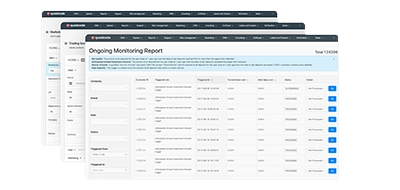Back
Contents
What is the Parabolic SAR Indicator?

Iva Kalatozishvili
Business Development Manager

Demetris Makrides
Senior Business Development Manager
The Parabolic Stop and Reverse indicator is a popular tool among traders for determining the direction of an asset’s price movement and detecting probable market reversals. The PSAR evaluates the current trend to assist traders determine whether or not to enter the market. This analysis is shown on a chart as a sequence of dots that are either above or below the candle bars.
Definition and Formula
How on a chart is the parabolic SAR calculated and shown? Using a formula, PSAR indicator creates a parabolic curve on a price chart that adjusts to reflect price changes. The indicator is more sensitive to price changes as time goes on using an acceleration factor (AF) that progressively increases as the trend advances. The main formula is as follows:
For an uptrend:
PSAR = Prior SAR + Prior AF x (Prior EP - Prior PSAR)
For a downtrend:
PSAR = Prior SAR - Prior AF x (Prior PSAR - Prior EP)
Where:
- SAR: Stop and Reverse value.
- AF: Acceleration Factor, starting at 0.02 and increasing by 0.02 with each new extreme point. Maximum value goes up to 0.20.
- EP: Extreme Point, the highest high during an uptrend or the lowest low during a downtrend.
- SAR: Stop and Reverse value.
- AF: Acceleration Factor, starting at 0.02 and increasing by 0.02 with each new extreme point. Maximum value goes up to 0.20.
- EP: Extreme Point, the highest high during an uptrend or the lowest low during a downtrend.
This formula produces a curve that reflects the price trend. When the price crosses the SAR level, it indicates a possible reversal, encouraging traders to consider switching from long to short or the other way around.
How Accurate Is Parabolic SAR?
The accuracy of the Parabolic SAR is greatly determined by market circumstances. It works especially effectively in trending markets when prices move consistently in one direction. In such cases, the Parabolic SAR may offer timely indications for initiating or abandoning trades, enabling traders to capitalize on the trend successfully.
Conversely, the Parabolic SAR may provide erroneous indications in range or sideways markets with irregular price movements that lack a clear direction. The frequent crossing of prices over the SAR may cause “whipsaws,” forcing traders to buy and terminate positions prematurely. This happens because the indicator is intended to track trends and can be deceived by short-term volatility.
How to Use Parabolic SAR?
Parabolic SAR is a technical indicator that may be used to create dynamic stop-loss orders, detect trend directions, and select the best entry and exit locations. Traders interpret the SAR dots in terms of price bars on a chart. When the SAR dots fall below the price bars, it indicates an upward trend that has positive momentum, meaning that traders could choose to keep or initiate long positions as prices are projected to keep increasing. Conversely, a negative attitude and declining trend are indicated when the SAR dots span the price bars. This suggests that prices may decline and that traders may consider exiting existing long transactions or entering short positions.
The timing of entries and exits can be improved by the observation of variations in the SAR dots. But despite the fact that the Parabolic SAR generates opportune signals, it should not be used in isolation. Market circumstances such as volatility and trend strength may have an influence on signal dependability, therefore further analysis of the market is required to enhance decision-making.
The Parabolic SAR also helps provide dynamic stop-loss orders that track price movement, allowing for better risk management. Traders may secure gains as the price rises positively while also limiting possible losses in the case of a market reversal by adjusting their stop-loss levels to the current SAR value as the trend develops. In an uptrend, for example, a trader may set his stop-loss immediately below the most recent SAR dot and modify it higher as the price rises. This strategy guarantees that the stop-loss order follows the market trend, providing an organized approach to safeguard profits without requiring frequent hands-on adjustments by the trader.
What Is the Best Value for Parabolic SAR?
In the default circumstances, the starting acceleration factor of the Parabolic SAR is 0.02. This factor rises by 0.02 with each additional extreme point, reaching a maximum of 0.20. Even if these settings are considered to be conventional, it is possible that they are not the most effective for every potential trading scenario. Using a smaller AF, such as 0.01, can diminish the indicator’s sensitivity to price movements, and this can help mitigate false signals in markets with high volatility. However, it may delay reaction to actual trend reversals, potentially resulting in missed opportunities. On the other hand, the Parabolic SAR becomes more responsive when the AF is increased to 0.03 or higher, resulting in the generation of signals for entries and exits that are generated more quickly. This heightened sensitivity is advantageous in markets that are strongly trending; however, it may result in a greater number of false signals in markets with frequent price actions.
Factors such as the asset’s volatility, trading time frames, and individual risk capacity are the determining factors in establishing the optimal AF value. Swing traders who hold positions for an extended period may choose a lesser AF to remove market noise, while day traders who concentrate on short-term fluctuations may favor a higher AF for greater sensitivity. To determine the ideal parameters, traders should backtest different AF values against historical data to see how the indicator performs under different scenarios. The Parabolic SAR’s efficacy in identifying trends and making informed decisions can be improved by traders who customize the acceleration factor to correspond with specific assets and market conditions.
Is Parabolic SAR Profitable?
Whether or not the Parabolic SAR is profitable is significantly influenced by its integration into a comprehensive trading strategy. Traders can effectively capture significant price movements by utilizing the Parabolic SAR, which provides distinct entry and exit signals in markets with strong, sustained trends. Its ability to create trailing stop-loss levels helps manage risk and protect gains by modifying the stop-loss in response to the current trend. Again, the importance of a trending market must be highlighted in this case.
However, in markets with no apparent directional trends, the indicator’s proficiency decreases because of misleading signals from frequent reversals and small changes. Relying entirely on the Parabolic SAR in these situations might result in losses. To increase profitability, utilize the Parabolic SAR with other technical indicators to confirm signals and decrease false positives. Additionally, understanding the broader market context and applying good risk management processes, such as proper position size and disciplined stop-loss and take-profit methods, are crucial for long-term success when using the Parabolic SAR.
Pros and Cons
The Parabolic SAR is becoming more popular among traders, owing to its several benefits. One of its main merits is its simplicity and use. The visual portrayal of the indication on price charts, as dots appear above or below the price bars, provides instant and clear insights into the market’s trend direction and probable reversal points. It is easily available to traders of all levels of experience, including beginners who may find it difficult to interpret complex indicators. Its simple nature enables traders to readily include it into their research without requiring substantial training.
The indicator’s flexibility across multiple time frames and markets adds yet another advantage. Through the use of the PSAR, it is possible to successfully trade commodities, currencies, shares, or cryptocurrency. Traders are able to tailor the indicator to their own goals and methods on account of its adaptability to a wide variety of trading techniques, including swing trading, day trading, and long-term investment, among others.
In addition, as mentioned before, the Parabolic SAR improves risk management by setting dynamic stop-loss levels. As the price moves in favor of a transaction, the SAR dots follow the price, thereby offering a systematic approach to adjusting stop-loss orders. This trailing stop function protects the profits while also adding discipline to trading strategies by promoting adherence to predefined exit strategies rather than emotional decisions.
The Parabolic SAR, however, has its drawbacks. One notable drawback is the effectiveness in markets that are turbulent or sideways. Frequent and unreliable signals may be generated by the indicator during periods in which there is no significant directional trend. SAR dots may move swiftly above and below the price bars as a result of the price fluctuating around a specific level. Traders may experience whipsaws, resulting in transaction costs and potential losses without substantial gains.
The Parabolic SAR’s sensitivity can also result in false signals during periods of elevated volatility. The indicator may indicate a trend reversal that does not occur and may prompt premature exits or entries due to sudden price surges or declines. Adjusting the acceleration factor may help to reduce this problem, but finding the best option needs careful consideration and may change depending on the asset and market circumstances.
Yet another disadvantage of the Parabolic SAR is that it fails to consider the fundamental factors that influence the market. This indicator is exclusively technical in nature, as it is reliant on historical price data and disregards economic data, company performance, political developments, and other fundamental factors that can have a substantial impact on asset prices. Critical information that could influence traders’ trading decisions may be overlooked by those who exclusively depend on the Parabolic SAR. As a result, it is not recommended to utilize it in isolation.
Furthermore, being a trailing indicator, the Parabolic SAR may respond after major price moves have taken place. This latency can result in traders missing the most advantageous entry or exit points, particularly in markets that are swiftly changing and have quick price fluctuations.
The need for frequent modifications must also be taken into account. The best Parabolic SAR parameters vary substantially based on the asset, market circumstances, and time period under consideration. Traders may need to constantly adjust the AG and maximum step values to keep the indicator effective, which may be time-consuming and requires a deep understanding of how these factors affect its performance.
Is Parabolic SAR Good for Scalping?
The Parabolic SAR is suitable for scalping because of its ability to detect short-term trend shifts, offering fast entry and exit signals that correspond to the quick decision-making necessary in this trading method. When set up with greater sensitivity levels, the indicator reacts quickly to price fluctuations, assisting traders in identifying microtrends within intraday price action. Scalpers might take advantage of short-lived trading opportunities that would otherwise go unnoticed with less sensitive indicators.
However, the enhanced sensitivity required for scalping might result in a greater number of false signals, particularly in extremely volatile markets. Frequent price changes may lead the indicator to quickly switch between buy and sell signals. This might drive up transaction costs and possible losses, reducing profitability. To address these issues, consider combining the Parabolic SAR with other short-term technical indicators, such as stochastic oscillators or Bollinger Bands, to provide extra confirmation and improve the dependability of trading choices.
Conclusion
The Parabolic SAR is a simple but powerful indicator that may spot market trends and probable reversal points. It is a popular trading method because of its simple visual signals, and it has the ability to improve decision-making and trading performance when combined with other analytical tools as part of a larger trading strategy. To use this indicator successfully, traders must understand its limits and alter its settings based on market circumstances.
Updated:
December 19, 2024
19 December, 2025
Top 10 White Label Casino Providers 2026
A white label casino is a ready-made online gambling platform that lets entrepreneurs start their own brand without building technology or securing licenses from scratch. In 2026, this model remains the fastest and most affordable way to enter the iGaming market. The leading white label casino providers in 2026 are SoftSwiss, BetConstruct, NuxGame, SoftGamings, FintechFuel, […]

8 December, 2025
How to Create an Online Casino Platform in 2026
The online casino market reached $19 billion in 2024 and, therefore, will present a massive opportunity for business owners in 2026. More than 60% of online gamblers now prefer mobile options to access digital gambling platforms, which can be attributed to increased internet and mobile use. Moreover, experts forecast a 12.2% annual growth through 2030, […]



